Land Degradation Monitoring in the Ordos Plateau of China Using an Expert Knowledge and BP-ANN-Based Approach
Abstract
:1. Introduction
2. Materials and Methods
2.1. Study Area
2.2. Research Framework
2.3. Method
2.3.1. Construction of Land Degradation Detecting Knowledge
2.3.2. Establishment of Land Degradation Detecting Model Based on the BP-ANN Algorithm
2.3.3. Land Degradation Monitoring Using Dynamic Analysis
2.4. Data Sources
3. Results
3.1. Modeling and Validation of Land Degradation Detection
3.2. Temporal Variation of Land Degradation in the Ordos Plateau
3.3. Inter-Annual Change of Land Degradation in the Ordos Plateau
3.4. Spatial Change of Land Degradation in the Ordos Plateau
4. Discussion
4.1. Indicators, Expert Knowledge and BP-ANN Algorithm for Monitoring Land Degradation
4.2. Land Degradation and Its Control in the Ordos Plateau
5. Conclusions
Acknowledgments
Author Contributions
Conflicts of Interest
References
- United Nations Convention to Combat Desertification. United Nations Convention to Combat Desertification in Countries Experiencing Serious Drought and/or Desertification, Particularly in Africa; United Nations Convention to Combat Desertification: Paris, France, 1994. [Google Scholar]
- Millennium Ecosystem Assessment (MA). Ecosystems and Human-Being: Desertification Synthesis; World Resources Institute: Washington, DC, USA, 2005. [Google Scholar]
- Vero’n, S.R.; Paruelo, J.M.; Oesterheld, M. Assessing desertification. J. Arid Environ. 2006, 4, 751–763. [Google Scholar] [CrossRef]
- Daily, G.C. Restoring Value to the World’s Degraded Lands. Science 1995, 269, 350–354. [Google Scholar] [CrossRef] [PubMed]
- Prince, S.; Becker-Reshef, I.; Rishmawi, K. Detection and mapping of long-term land degradation using local net production scaling: Application to Zimbabwe. Remote Sens. Environ. 2009, 113, 1046–1057. [Google Scholar] [CrossRef]
- D’Odorico, P.; Bhattachan, A.; Davis, K.F. Global desertification: Drivers and feedbacks. Adv. Water Resour. 2013, 51, 326–344. [Google Scholar] [CrossRef]
- Vogt, J.V.; Safriel, U.; von Maltitz, G.; Sokona, Y.; Zougmore, R.; Bastin, G.; Hill, J. Monitoring and Assessment of Land Degradation and Desertification: Towards New Conceptual and Integrated Approaches. Land Degrad. Dev. 2011, 22, 150–165. [Google Scholar] [CrossRef]
- Verstraete, M.M.; Scholes, R.J.; Smith, M.S. Climate and desertification: Looking at an old problem through new lenses. Front. Ecol. Environ. 2009, 7, 421–428. [Google Scholar] [CrossRef]
- Jong, R.D.; Bruin, S.D.; Dent, M.S.D. Quantitative mapping of global land degradation using earth observations. Int. J. Remote Sens. 2011, 32, 6823–6853. [Google Scholar] [CrossRef] [Green Version]
- Dawelbait, M.; Morari, F. Monitoring desertification in a Savannah region in Sudan using Landsat images and spectral mixture analysis. J. Arid Environ. 2012, 80, 45–55. [Google Scholar] [CrossRef]
- Dawelbait, M.; Morari, F. Limits and Potentialities of Studying Dryland Vegetation Using the Optical Remote Sensing. Ital. J. Agron 2008, 3, 97–106. [Google Scholar] [CrossRef]
- Smith, M.O.; Ustin, S.L.; Adams, J.B.; Gillespie, A.R. Vegetation in deserts: I. A regional measure of abundance from multispectral images. Remote Sens. Environ. 1990, 31, 1–26. [Google Scholar]
- Ringrose, S.; Matheson, W.; Tempest, F. The development and cause of range degradation in southeast Botswana using multi-temporal Landsat MSS imagery. Photogramm. Eng. Remote Sens. 1990, 9, 1253–1262. [Google Scholar]
- Roig, F.A.; Gonzalez-Loyarte, M.; Abraham, E.M.; Méndez, E.; Roig, V.G.; Martinez Carretero, E. Maps of desertification hazards of Central Western Argentina, (Mendoza Province). In World Atlas of Thematic Indicators of Desertification; Arnold, E., Ed.; United Nations Environment Programme: London, UK, 1991. [Google Scholar]
- Del Valle, H.F.; Elissalde, N.O.; Gagliardini, D.A.; Milovich, J. Status of desertification in the Patagonian region: Assessment and mapping from satellite imagery. Arid Soil Res. Rehabil. 1998, 12, 95–121. [Google Scholar]
- Wu, B.; Ci, L.J. Landscape change and desertification development in the Mu Us Sandland, Northern China. J. Arid Environ. 2002, 50, 429–444. [Google Scholar] [CrossRef]
- Li, F.; Zhang, B.; Su, W.; He, Y.F.; Wang, Z.M.; Song, K.S.; Li, D.W.; Li, Z.M. Sandy desertification change and its driving forces in western Jilin Province, North China. Environ. Monit. Assess. 2008, 136, 379–390. [Google Scholar]
- Zhang, Y.Z.; Chen, Z.Y.; Zhu, B.Q.; Luo, X.Y.; Guan, Y.N.; Guo, S.; Nie, Y. Land desertification monitoring and assessment in Yulin of Northwest China using remote sensing and geographic information systems (GIS). Environ. Monit. Assess. 2008, 147, 327–337. [Google Scholar] [CrossRef] [PubMed]
- Yan, C.Z.; Song, X.; Duan, H.C.; Li, S. Assessment of Aeolian desertification trends from 1975’s to 2005’s in the watershed of the Longyangxia Reservoir in the upper reaches of China’s Yellow River. Geomorphology 2009, 112, 205–211. [Google Scholar] [CrossRef]
- Cui, Y.; Li, R. Analysis on dynamic change of desertification of Kubuqi Desert. Sci. Soil Water Conserv. 2010, 4, 57–60. (In Chinese) [Google Scholar]
- Liu, Y.F.; Li, J.X.; Bao, Y.H. Dynamic analysis of desertification in the western of ordos plateau- the case of etoke banner. J. Inn. Mong. Agric. Univ. 2011, 4, 80–87. (In Chinese) [Google Scholar]
- Wang, T.; Song, X.; Yan, C.Z.; Li, S.; Xie, J.L. Remote Sensing Analysis on Aeolian Desertification Trends in Northern China during 1975–2010. J. Desert Res. 2011, 6, 1351–1356. (In Chinese) [Google Scholar]
- Xue, Z.J.; Qin, Z.D.; Li, H.J.; Ding, G.W.; Meng, X.W. Evaluation of Aeolian desertification from 1975 to 2010 and its causes in northwest Shanxi Province, China. Glob. Planet. Chang. 2013, 107, 102–108. [Google Scholar] [CrossRef]
- Wu, W. Method and Practice of Remote Sensing Monitoring on Desertification Development. Remote Sens. Technol. Appl. 1997, 4, 14–20. (In Chinese) [Google Scholar]
- Wu, J.; Peng, D.L. Advances in Researches on Desertification Evaluation Technology Based on Remote Sensing. World For. Res. 2009, 5, 34–39. (In Chinese) [Google Scholar]
- Lanfredi, M.; Lasaponara, R.; Simoniello, T.; Cuomo, V.; Macchiato, M. Multi-resolution spatial characterization of land degradation phenomena in southern Italy from 1985 to 1999 using NOAA-AVHRR NDVI data. Geophys. Res. Lett. 2003, 2, 1069. [Google Scholar] [CrossRef]
- Runnström, M.C. Rangeland development of the Mu Us sandy land in semiarid China: An analysis using Landsat and NOAA remote sensing data. Land Degrad. Dev. 2003, 14, 189–202. [Google Scholar] [CrossRef]
- Masellif, F.; Rembold, F. Integration of LAC and GAC NDVI data to improve vegetation monitoring in semi-arid environments. Int. J. Remote Sens. 2002, 12, 2475–2488. [Google Scholar] [CrossRef]
- Symeonakis, E.; Drake, N. Monitoring desertification and land degradation over sub-Saharan Africa. Int. J. Remote Sens. 2004, 3, 573–592. [Google Scholar] [CrossRef]
- Lambin, E.F.; Ehrlich, D. Land-cover changes in sub-saharan Africa (1982–1991): Application of a change index based on remotely sensed surface temperature and vegetation indices at a continental scale. Remote Sens. Environ. 1997, 61, 181–200. [Google Scholar] [CrossRef]
- Collado, A.; Chuvieco, E.; Camarasa, A. Satellite remote sensing analysis to monitor desertification processes in the crop-rangeland boundary of Argentina. J. Arid Environ. 2002, 52, 121–133. [Google Scholar] [CrossRef]
- Prince, S.; de Colstoun, E.; Kravitz, L. Evidence from rain-use efficiencies does not indicate extensive Sahelian desertification. Glob. Chang. Biol. 1998, 4, 359–374. [Google Scholar] [CrossRef]
- Haboudane, D.; Bonn, F.; Royer, A.; Sommer, S.; Mehl, W. Land degradation and erosion risk mapping by fusion of spectrally-based information and digital geomorphometric attributes. Int. J. Remote Sens. 2002, 23, 3795–3820. [Google Scholar] [CrossRef]
- Wessels, K.; Prince, S.; Frost, P.; van Zyl, D. Assessing the effects of human-induced land degradation in the former homelands of northern South Africa with a 1 km AVHRR NDVI time-series. Remote Sens. Environ. 2004, 91, 47–67. [Google Scholar] [CrossRef]
- Wessels, K.; Prince, S.; Malherbe, J.; Small, J.; Frost, P.; van Zyl, D. Can human-induced land degradation be distinguished from the effects of rainfall variability? A case study in South Africa. J. Arid Environ. 2007, 68, 271–297. [Google Scholar]
- Wessels, K.; Prince, S.; Reshef, I. Mapping land degradation by comparison of vegetation production to spatially derived estimates of potential production. J. Arid Environ. 2008, 72, 1940–1949. [Google Scholar] [CrossRef]
- Wessels, K.; van den Bergh, F.; Scholes, R. Limits to detectability of land degradation by trend analysis of vegetation index data. Remote Sens. Environ. 2012, 125, 10–22. [Google Scholar] [CrossRef]
- Zika, M.; Erb, K. The global loss of net primary production resulting from human-induced soil degradation in drylands. Ecol. Econ. 2009, 69, 310–318. [Google Scholar] [CrossRef]
- Evans, J.; Geerken, R. Discrimination between climate and human-induced dryland degradation. J. Arid Environ. 2004, 57, 535–554. [Google Scholar] [CrossRef]
- Zhou, W.; Gang, C.; Zhou, F.; Li, J.; Dong, X.; Zhao, C. Quantitative assessment of the individual contribution of climate and human factors to desertification in northwest China using net primary productivity as an indicator. Ecol. Indic. 2015, 48, 560–569. [Google Scholar] [CrossRef]
- Reynolds, J.; Stafford Smith, D. Global Desertification: Do Humans Cause Deserts? Dahlem University Press: Berlin, Germany, 2002. [Google Scholar]
- Lin, D.G.; Yu, H.; Lian, F.; Wang, J.A.; Zhu, A.X.; Yue, Y.J. Quantifying the hazardous impacts of human-induced land degradation on terrestrial ecosystems: A case study of karst areas of south China. Environ. Earth Sci. 2016, 75, 1127. [Google Scholar] [CrossRef]
- Haberl, H.; Erb, K.; Krausmann, F. Human Appropriation of Net Primary Production: Patterns, Trends, and Planetary Boundaries. Annu. Rev. Environ. Resour. 2014, 39, 363–391. [Google Scholar] [CrossRef]
- Ma, J.H.; Cai, D.H.; Xiao, T. Qualified evaluating on the remote sensing of desertification—A case study of the Erdos region. J. Lanzhou Univ. (Nat. Sci.) 2007, 4, 1–6. (In Chinese) [Google Scholar]
- Pan, J.H.; Liu, T.Y. Extracting desertification from Landsat TM imagery based on spectral mixture analysis and Albedo-Vegetation feature space. Nat. Hazards 2013, 2, 915–927. [Google Scholar] [CrossRef]
- Xu, J.X. Sand-dust storms in and around the Ordos Plateau of China as influenced by land use change and desertification. Catena 2006, 65, 279–284. [Google Scholar] [CrossRef]
- Wu, W. Study on processes of desertification in Mu Us Sandy Land for last 50 years, China. J. Desert Res. 2001, 21, 164–169. (In Chinese) [Google Scholar]
- Wu, B.; Ci, L.J. Causes and development stages of desertification in the Mu Us Sandland. Chin. Sci. Bull. 1998, 43, 2437–2440. (In Chinese) [Google Scholar]
- Yue, Y.; Shi, P.; Zou, X.; Ye, X.; Zhu, A.; Wang, J. The measurement of wind erosion through field survey and remote sensing: A case study of the Mu Us Desert, China. Nat. Hazards 2015, 76, 1497–1514. [Google Scholar]
- Yue, Y.; Ye, X.; Zou, X.; Wang, J.; Gao, L. Research on land use optimization for reducing wind erosion in sandy desertified area: A case study of Yuyang County in Mu Us Desert, China. Stoch. Environ. Res. Risk Assess. 2016, 1–17. [Google Scholar] [CrossRef]
- Robinove, C.J.; Chavez, P.S.; Gehring, D.; Holmgren, R. Arid Land Monitoring Using Landsat Albedo Difference Images. Remote Sens. Environ. 1981, 11, 133–156. [Google Scholar] [CrossRef]
- Lira, J. A Model of Desertification Process in a Semi-arid Environment Employing Multi-spectral Images. In Progress in Pattern Recognition, Image Analysis and Applications; Springer: Heidelberg, Germany, 2004. [Google Scholar]
- Liang, S.L. Narrowband to broadband conversions of land surface albedo I Algorithms. Remote Sens. Environ. 2000, 76, 213–238. [Google Scholar] [CrossRef]
- Zhu, A.X.; Wang, R.X.; Qiao, J.P.; Qin, C.Z.; Chen, Y.B.; Liu, J.; Du, F.; Lin, Y.; Zhu, T.X. An expert knowledge-based approach to landslide susceptibility mapping using GIS and fuzzy logic. Geomorphology 2014, 214, 128–138. [Google Scholar] [CrossRef]
- Zhu, A.X. A personal construct-based knowledge acquisition process for natural resource mapping. Int. J. Geogr. Inf. Sci. 1999, 13, 119–141. [Google Scholar] [CrossRef]
- Yue, Y.; Wang, J.; Lv, H.; Liu, J.; Wang, Z.; Li, L. Land Use Optimization at Ecological Security Level in Desert Regions–A case study of Horqin Sandy Land. In Progress in Safety Science and Technology Volume V (Part B); Li, S.C., Wang, Y.J., Huang, P., Eds.; Science Press: Beijing, China, 2005; pp. 2111–2116. [Google Scholar]
- Yue, Y.; Zhou, H.; Wang, J.; Shi, P.; Lv, H.; He, C.; Yan, P. Research on the land use structure of Asian desert regions at ecological security level. Adv. Earth Sci. 2006, 21, 131–137. (In Chinese) [Google Scholar]
- Yue, Y.; Wang, J.; Yi, X.; Shi, P.; Zou, X.; Zhang, F. Risk assessment of Aeolian sand disaster in cities in sandy area of northern China based on RS, GIS and models. J. Nat. Disasters 2008, 17, 15–20. (In Chinese) [Google Scholar]
- Yue, Y.; Wang, J.; Zou, X.; Shi, P. Assessment on the risk of Aeolian sand disasters around the lakes and reservoirs in sandy lands in north China and some security measures: A case study in a sandy land in Inner Mongolia. Arid Zone Res. 2008, 25, 574–582. (In Chinese) [Google Scholar]
- Yue, Y.; Wang, J. Land Use Change and Optimization in Desertified Area; Science Press: Beijing, China, 2011. [Google Scholar]
- Yi, X.; Yin, Y.; Yue, Y. Temporal and spatial changes of residential land in the Yuyang desert region of northern Shaanxi Province in recent 20 years. Front. Earth Sci. 2012, 6, 250–260. [Google Scholar] [CrossRef]
- Yue, Y.J.; Yan, W.N.; Wang, X.H.; Shen, Y.C.; Qiu, M.M.; Zhou, L.; Li, J. Impacts of the ecological restoration program on regional ecosystem services: A case of Yanchi County, Ningxia Autonomous Region. J. Arid Land Resour. Environ. 2014, 28, 60–67. (In Chinese) [Google Scholar]
- Benediktsson, J.A.; Swain, P.H.; Ersoy, O.K. Neural network approaches versus statistical methods in classification of Multisource remote sensing data. Trans. Geo-Sci. Remote Sens. 1990, 28, 540–552. [Google Scholar] [CrossRef]
- Qiao, P.L.; Zhang, J.X.; Lin, Z.J. An Artificial Neural Network Method for the Information of Desertification Extraction. J. Surv. Mapp. 2004, 1, 58–62. (In Chinese) [Google Scholar]
- Mamat, S.; Tashpolat, T.; Ding, J.L.; He, Q.S. Study on Extracting the Information about desertified Lands Based on Principal Component Fusion and BP Neural Network. Arid Zone Res. 2008, 5, 647–652. (In Chinese) [Google Scholar]
- Zhu, H.Y.; Li, X.B. Discussion on the Index method of regional land use change. Acta Geogr. Sin. 2003, 5, 643–650. (In Chinese) [Google Scholar]
- Zhang, G.; Dong, J.; Xiao, X.; Hu, Z.; Sheldon, S. Effectiveness of ecological restoration projects in Horqin Sandy Land, China based on SPOT-VGT NDVI data. Ecol. Eng. 2012, 38, 20–29. [Google Scholar] [CrossRef]
- Cao, S. Why large-scale afforestation efforts in China have failed to solve the desertification problem. Environ. Sci. Technol. 2008, 42, 1826–1831. [Google Scholar] [CrossRef] [PubMed]
- Wang, X.; Zhang, C.; Hasi, E.; Dong, Z. Has the Three Norths Forest Shelterbelt Program solved the desertification and dust storm problems in arid and semiarid China? J. Arid Environ. 2010, 74, 13–22. [Google Scholar] [CrossRef]
- Mason, J.A.; Swinehart, J.B.; Lu, H.Y.; Miao, X.D.; Cha, P.; Zhou, Y.L. Limited change in dune mobility in response to a large decrease in wind power in semi-arid northern China since the 1970s. Geomorphology 2008, 102, 351–363. [Google Scholar] [CrossRef]
- Chen, W.N.; Dong, G.R.; Dong, Z.B. Achievements and needs of studies on wind erosion in Northern China. Adv. Earth Sci. 1994, 9, 6–12. (In Chinese) [Google Scholar]
- Wang, T.; Zhu, Z.D. Some problems of desertification in northern China. Quat. Sci. 2001, 21, 56–65. (In Chinese) [Google Scholar]
- Zha, Y.; Liu, Y.S.; Deng, X.Z. A landscape approach to quantifying land cover changes in Yulin, Northwest China. Environ. Monit. Assess. 2008, 138, 139–147. [Google Scholar] [CrossRef] [PubMed]
- Huete, A.R. A soil-adjusted vegetation index (SAVI). Remote Sens. Environ. 1988, 25, 295–309. [Google Scholar] [CrossRef]
- Huete, A.R.; Hua, G.; Qi, J.; Chehbouni, A.; van Leeuwen, W.J.D. Normalization of multidirectional red and NIR reflectances with the SAVI. Remote Sens. Environ. 1992, 41, 143–154. [Google Scholar] [CrossRef]
- Wang, T. Study on Sandy Desertification in China-2.Contents of Desertification Research. J. Desert Res. 2003, 23, 477–482. (In Chinese) [Google Scholar]
- Wang, T.; Zhao, H. Fifty-year History of China Desert Science. J. Desert Res. 2005, 25, 145–165. [Google Scholar]
- United Nations Convention to Combat Desertification. Desertification-Coping with Today’s Global Challenges: In the Context of the Strategy of The United Nations Convention to Combat Desertification; High-Level Policy Dialogue: Bonn, Germany, 2008. [Google Scholar]
- Wang, T.; Sun, J.; Han, H.; Yan, C. The relative role of climate change and human activities in the desertification process in Yulin region of northwest China. Environ. Monit. Assess. 2011, 12, 7165–7173. [Google Scholar] [CrossRef] [PubMed]
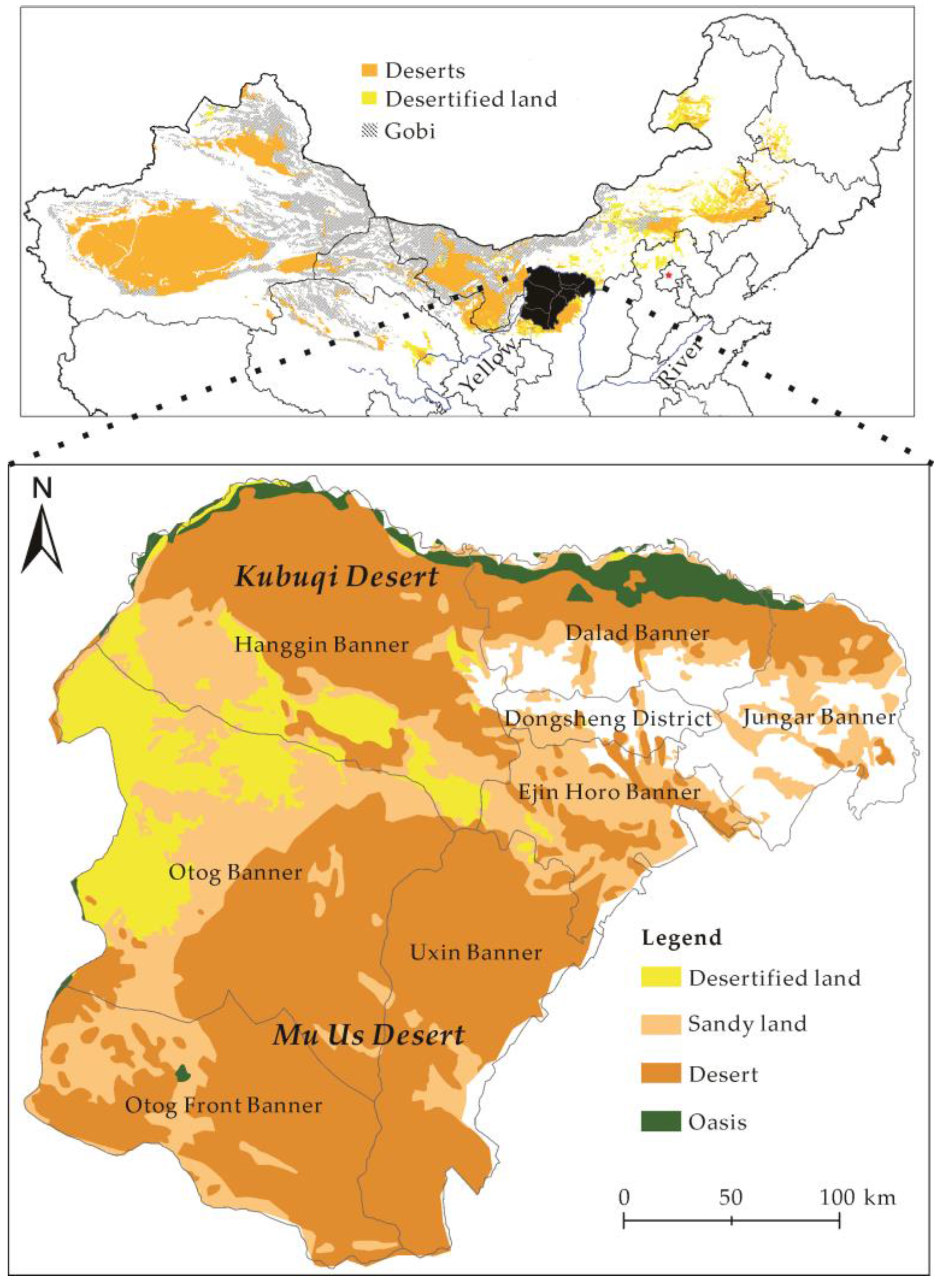



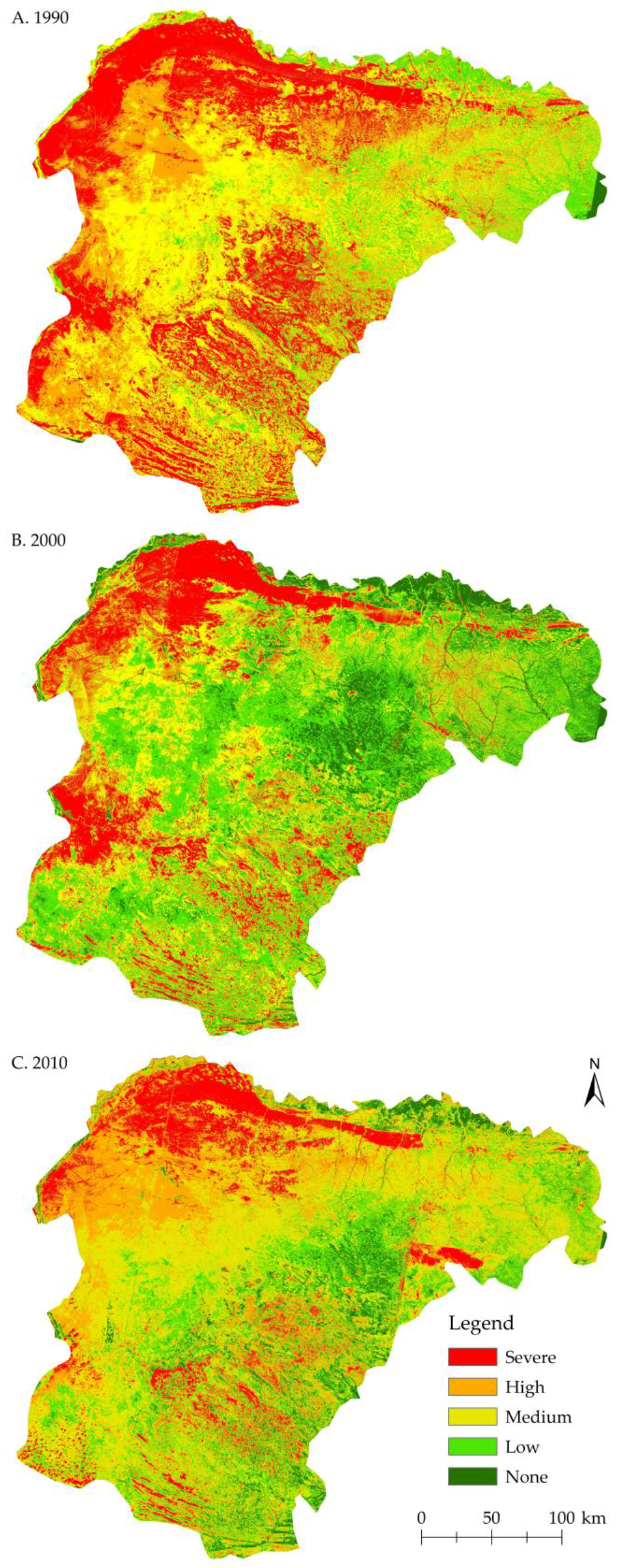
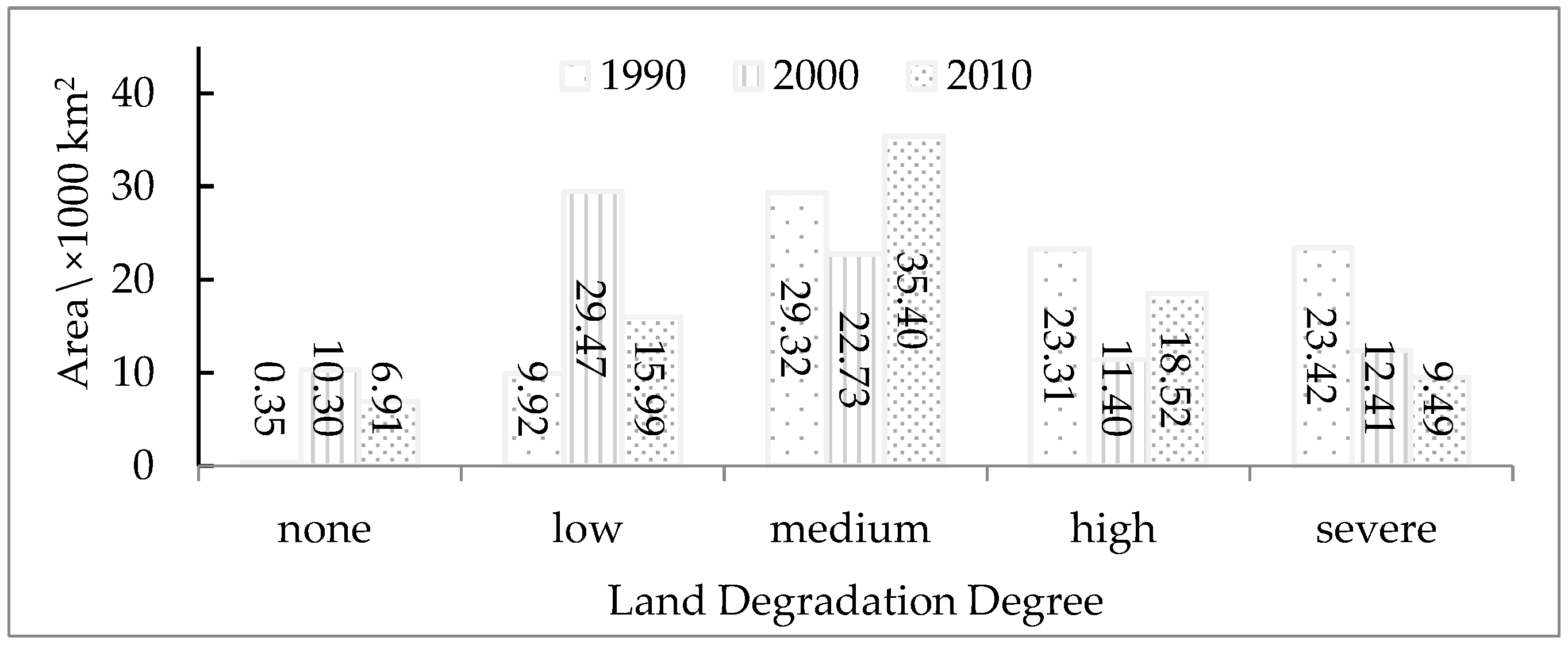
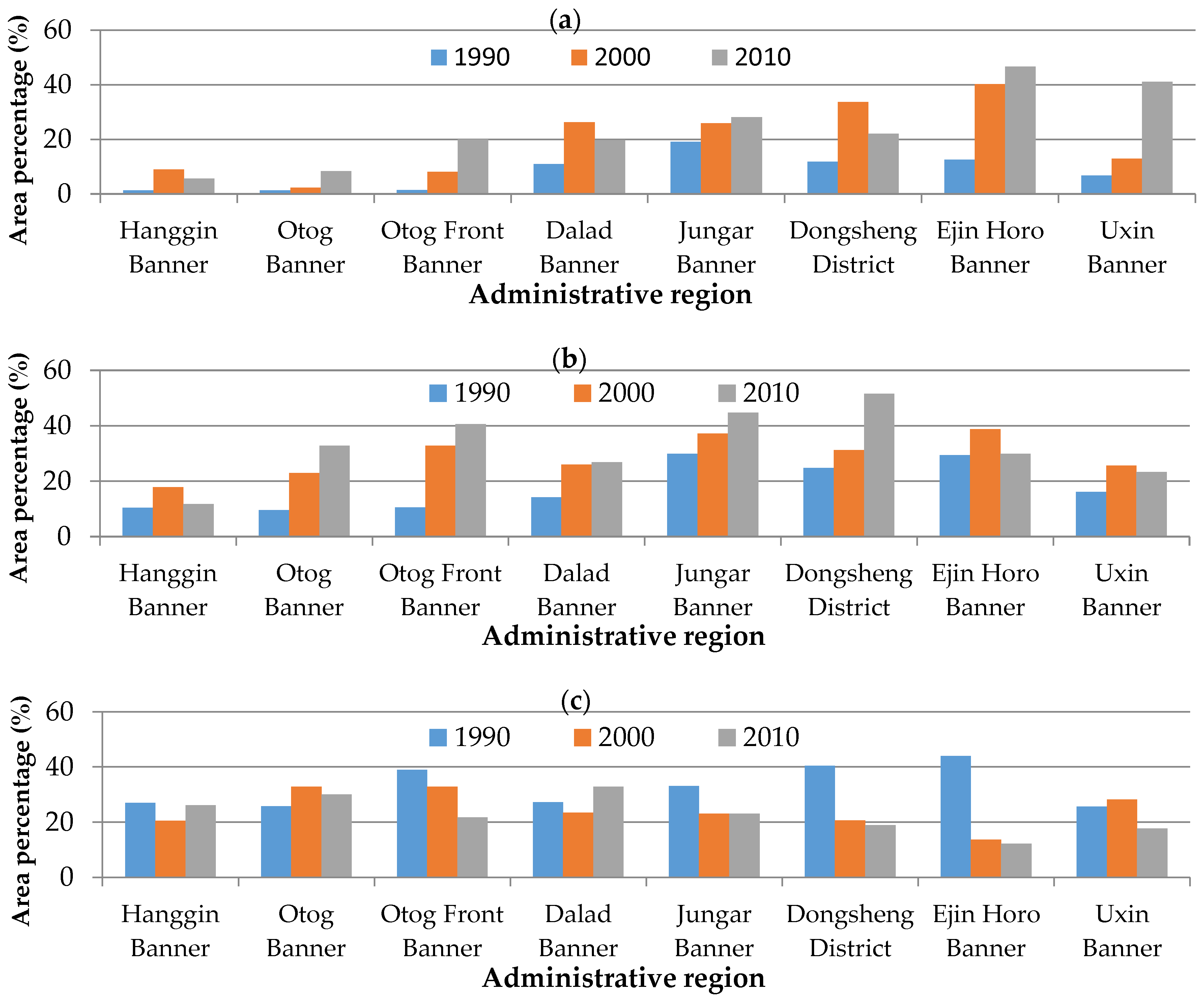


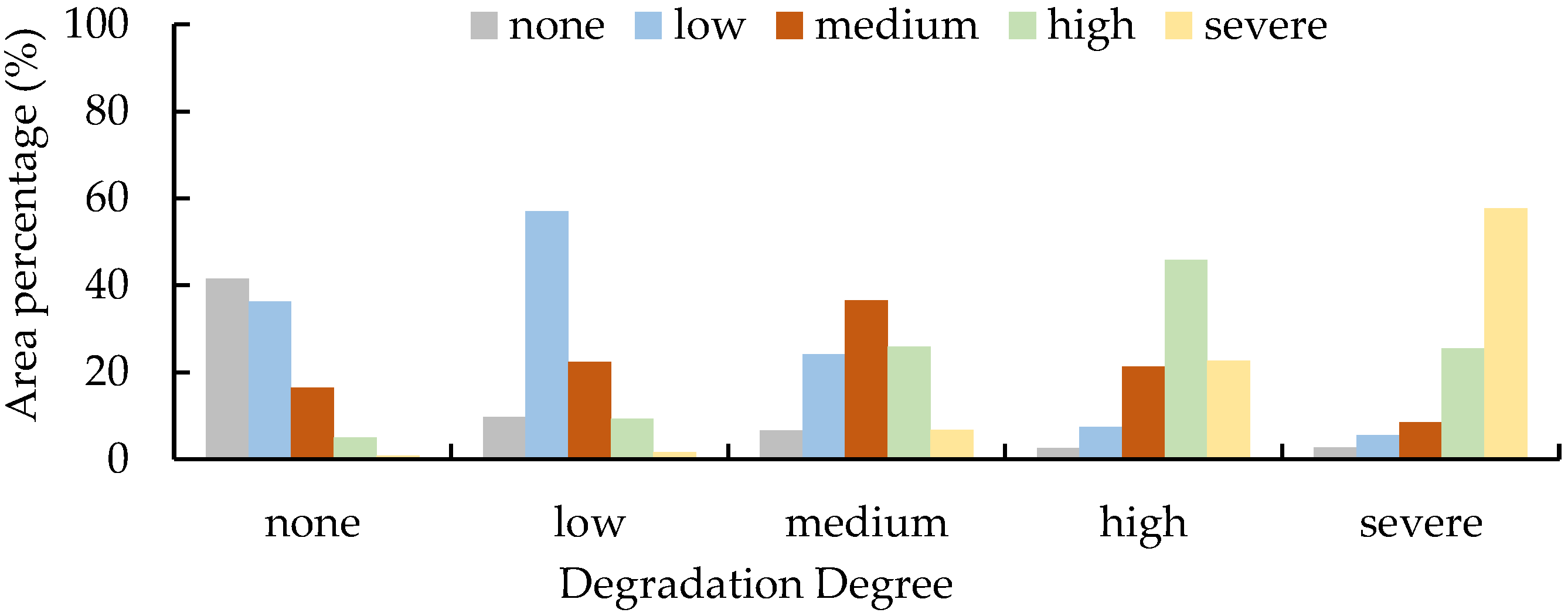

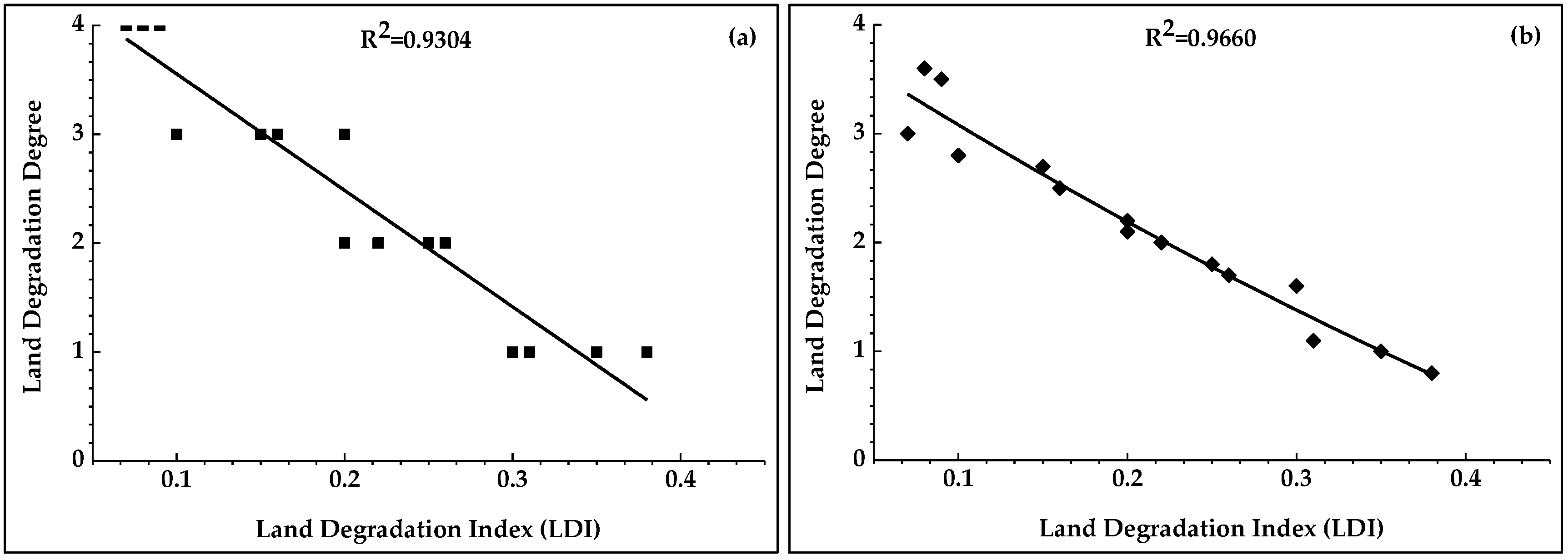
| Degradation Degree | Land Type | Visual Interpretation Keys | NDVI (−1–1) | Albedo (0–1) |
|---|---|---|---|---|
| None degradation | Fixed sand dunes or oasis grassland, farmland, dry steppe or desert steppe | Dark green, green, bright green, dark red, red, light red; irregular block | >0.3798 | <0.6614 |
| Low degradation | Fixed sandy land and eroded farmland, vegetation cover > 60% | Light red, or light red with red spots, irregular block | 0.3798–0.1385 | 0.6614–0.7522 |
| Medium degradation | Semi-fixed sandy land and bare gravel land, 30% < vegetation cover < 60% | Light red, irregular block, uneven ground, with distributed sand dunes | 0.1385–0.0150 | 0.7522–0.8290 |
| High degradation | Semi-shifting sandy land, vegetation cover < 30% | White and clear sand dune with dotted red, irregular block | 0.0150–−0.0150 | 0.8290–0.9154 |
| Sever degradation | Shifting sandy land or Gobi, vegetation cover < 10% | Distributed over a large area; uniform colors with very light blue-green or bright white; obvious sand dune and longitudinal dune; a crescent, lattice or wavy-shaped with a clear boundary | <−0.0150 | >0.9154 |
| Land Degradation Degree | None | Low | Medium | High | Severe | Total | Producer Precision | User Precision |
|---|---|---|---|---|---|---|---|---|
| None | 88 | 4 | 0 | 0 | 0 | 92 | 88% | 95.65% |
| Low | 8 | 88 | 3 | 0 | 0 | 99 | 88% | 88.89% |
| Medium | 4 | 6 | 90 | 2 | 2 | 104 | 90% | 86.54% |
| High | 0 | 2 | 5 | 95 | 3 | 105 | 95% | 90.48% |
| Server | 0 | 0 | 2 | 3 | 95 | 100 | 95% | 95% |
| Total | 100 | 100 | 100 | 100 | 100 | 500 |
© 2016 by the authors; licensee MDPI, Basel, Switzerland. This article is an open access article distributed under the terms and conditions of the Creative Commons Attribution (CC-BY) license (http://creativecommons.org/licenses/by/4.0/).
Share and Cite
Yue, Y.; Li, M.; Zhu, A.-x.; Ye, X.; Mao, R.; Wan, J.; Dong, J. Land Degradation Monitoring in the Ordos Plateau of China Using an Expert Knowledge and BP-ANN-Based Approach. Sustainability 2016, 8, 1174. https://doi.org/10.3390/su8111174
Yue Y, Li M, Zhu A-x, Ye X, Mao R, Wan J, Dong J. Land Degradation Monitoring in the Ordos Plateau of China Using an Expert Knowledge and BP-ANN-Based Approach. Sustainability. 2016; 8(11):1174. https://doi.org/10.3390/su8111174
Chicago/Turabian StyleYue, Yaojie, Min Li, A-xing Zhu, Xinyue Ye, Rui Mao, Jinhong Wan, and Jin Dong. 2016. "Land Degradation Monitoring in the Ordos Plateau of China Using an Expert Knowledge and BP-ANN-Based Approach" Sustainability 8, no. 11: 1174. https://doi.org/10.3390/su8111174
APA StyleYue, Y., Li, M., Zhu, A.-x., Ye, X., Mao, R., Wan, J., & Dong, J. (2016). Land Degradation Monitoring in the Ordos Plateau of China Using an Expert Knowledge and BP-ANN-Based Approach. Sustainability, 8(11), 1174. https://doi.org/10.3390/su8111174





